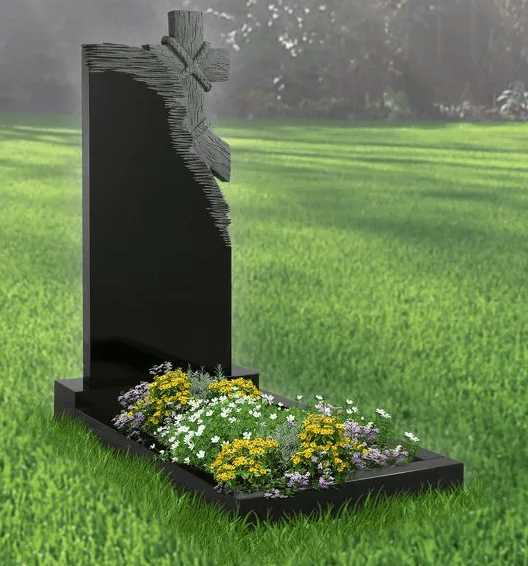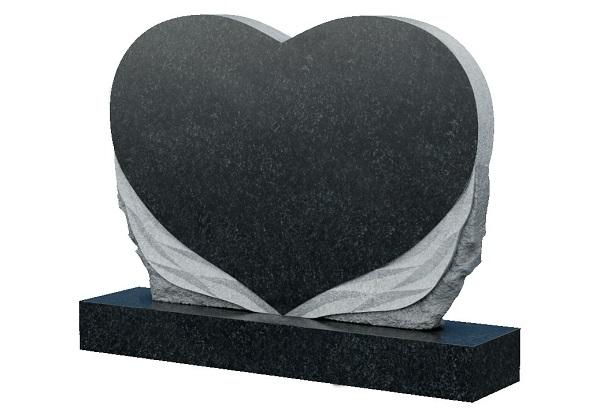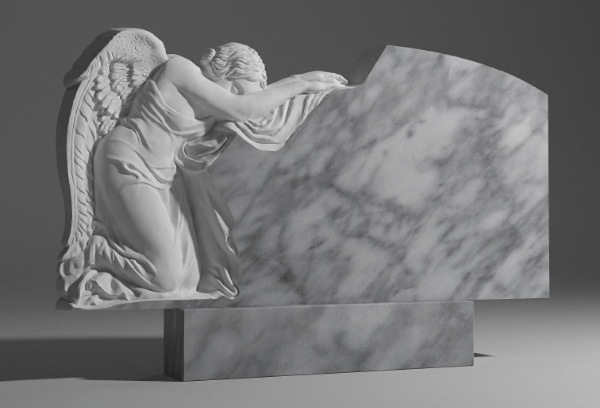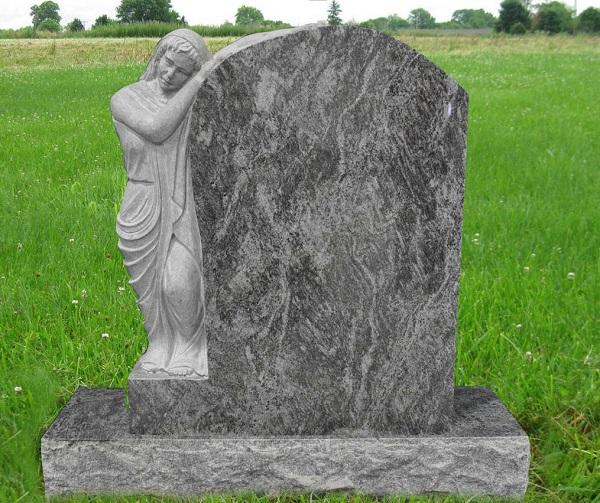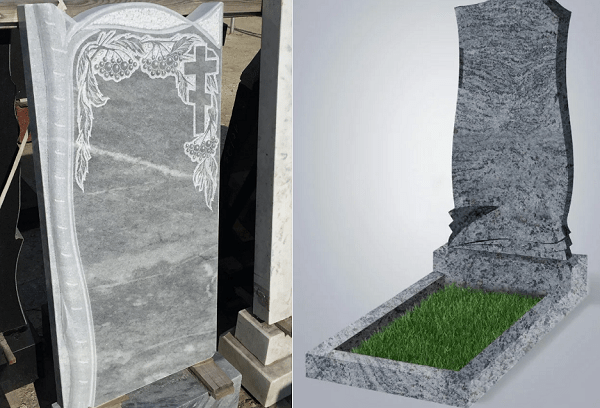Resistant granite or “living” marble – which is better and more expensive, more durable and better for a monument
Content:
Today, tombstones are made from a variety of materials. But the most popular remains natural stone - marble or granite. A comparative table, an analysis of the pros and cons, and reviews will help you decide what is best for the monument.
Why do most people choose granite for a monument?
Granite has no equal in durability. There is even a joke among craftsmen: “Only high-quality granite can be better than granite.”
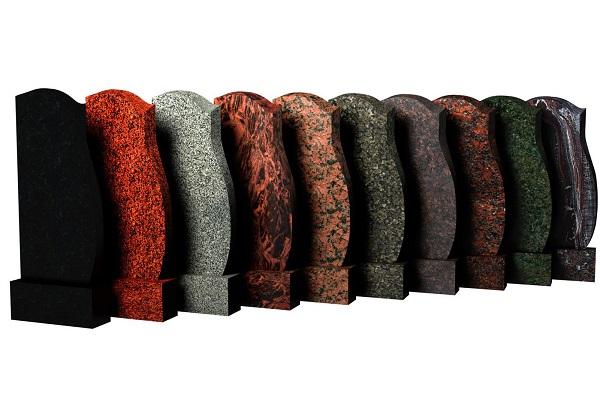
With all this, the material is very attractive in appearance. The sparkles of quartz, playing and shimmering in the sun, are mesmerizing. The following types of granite are most often used in the production of monuments:
- Ukrainian. Contains iron and may rust over time.
- Chinese. It comes in high quality and low quality. The best granite is “Shanxi” - homogeneous, with fine grain. The engraving on it is very clear. China has also become famous for passing off artificial granite as real, made from fine pressed chips, a mixture of stone and clay. You come across glued slabs with large inclusions of iron.
- Karelian gabbro diabase. It is characterized by high strength and durability. Without polishing it is gray in color, with polishing it is black. If you make a cut on it and do not polish it, it seems that the product consists of two different materials.
- Finnish. Popular with a large selection of “colored” breeds.
Advantages and disadvantages
Objectively, granite is the most popular material for monuments. And this is not at all an accident or fashion.
Natural stone has significant advantages:
- Granite is resistant to mechanical damage - it is difficult to leave scratches and chips on it.
- Easy to clean - dirt can be washed off with an ordinary damp cloth.
- Does not fade in the sun - the color of the stone remains in its original state for many years.
- Not subject to climatic influences - does not crumble, does not deform.
- Allows you to capture the image of the deceased using engraving - the portrait does not fade for 30-50 years.
- Extremely high service life - individual granite monuments can last up to 1000 years.
Minuses:
- Granite is more expensive than marble. Not everyone can afford to install a large granite monument, especially with carved elements and large engravings. The bill can amount to several hundred thousand rubles.
- A large amount of low-quality material, frequent installation errors. The high demand for granite attracts non-professionals to this industry. Granite monuments made in violation of technology can become covered with cracks, tilt and collapse.
What are the advantages of marble for a monument?
The Temple of Zeus was built from marble, the Venus de Milo and the famous columns of Artemis were carved.
The beautiful appearance of marble and its plasticity (as far as this word can be applied to stone) allow you to create real architectural masterpieces.
It absorbs the sun's rays, and due to this, subtle details are barely perceptible. A slight glow can be seen around the monument.
Advantages and disadvantages
For many centuries, marble has had no equal in durability. Tombstones dating back to the 15th century have been preserved. What is true is that they have lost their visual appeal and have become more like concrete. Advantages of marble for making a monument:
- Plastic – you can cut out complex shapes.
- Strength – does not deform or collapse for a long time.
- Price – prices for rectangular marble monuments are low. You can order a monument worth 14-15 thousand rubles.
- Attractive appearance. The marble angels bending over the grave look as if they were alive. You can see the smallest details in clothes, sadness in the eyes.
Minuses:
- Weak resistance to sub-zero temperatures. In severe frost, marble products can crack. They are not suitable for regions with frosty winters.
- Difficulty of care. It is recommended to wax or varnish marble once a year to close the pores and improve its wear resistance. In addition, deep professional cleaning is recommended every 3-5 years. Dirt can be retained in the pores of the material, which affects the appearance - the monument can become covered with stains and moss.
Important. Marble monuments are not engraved. Portraits are inserted into a small recess. Granite inserts with an engraved image are also often made.
What is the difference between them?
Among all the possible materials for monuments, granite and marble have no equal. Both are natural stone and have undeniable advantages: strength, durability, visual appeal.When professionally processed, they are not afraid of rain, wind, temperature changes, or time. But still granite and marble are very different from each other:
- Noble white marble. Monuments made from it look especially gentle and sophisticated. Granite is most often black, which emphasizes the mourning of the event. In addition to black, granite comes in gray, green, brown-red, purple and yellow. “Colored” options are in less demand, mainly for creating art objects.
- Marble is easier to process – smooth lines and small details are well worked out. Bas-reliefs and reliefs are often created from it, where the figure protrudes from the stone to half or less. Granite monuments usually have the form of a stele, pedestal or flower bed with strict lines.
comparison table
Strict granite or “living” marble is not an easy choice. Materials have advantages and disadvantages that need to be taken into account when ordering a monument. We suggest comparing them in the table:
| Marble | Granite | |
| A natural stone | + | + |
| Color | White, gray, less often others | Black, red-brown, less commonly others |
| Engraving | — | + |
| Statues and complex bas-reliefs | + | — |
| Easy to care for | — | + |
| Durability | 30-50 years, with regular care 100-150 years | 300-500 years |
| Price | From 13 thousand rubles. | From 17 thousand rubles |
Important. Although marble is cheaper as a material, complex monuments made from it will be incredibly expensive due to the cost of labor. The cost of individual marble monuments reaches 1 million rubles.
Which is better to choose?
A lot depends on the choice of material: price, appearance, durability of the product. But perhaps the main criterion remains service life. A broken monument is a sad sight. It is important that it stands for as long as possible, preserving the memory of a person for several generations.
Granite is considered the best material for a tombstone - it is more practical and durable.
A classic rectangular monument made of granite is best suited for men, older people with strict rules, and women with serious professions. If desired, the stele can be supplemented with artistic painting or ordered a figured monument with curved sides, laconic carvings, and an arch. The granite monument can be for children, women, double or triple.
Marble is better suited:
- To perpetuate the memory of a deceased person with a fine spiritual organization, a girl, a child. Many people choose a monument that best conveys a person’s features, character, soul and destiny. Marble allows you to embody non-standard ideas; it looks especially gentle and touching.
- For people with a small budget. A simple marble monument will not break your pocket. At the same time, it is very attractive, natural and quite wear-resistant if you care for it properly.
Advice. If you are choosing a granite monument and want the engraving to last as long as possible, you should look for a good artist. With the manual method, images are preserved longer - up to 50 years.
But for the most part, companies offer machine engraving on granite. This guarantees true resemblance to the original. The downside is that the image is not as deep as with manual work, and it fades after 30 years.
Reviews of monuments made of granite and marble
Often, before choosing this or that material for a monument, people read reviews. They can contain valuable information and advice. But you should also take into account that many manufacturing companies publish custom reviews on their websites. On the contrary, they leave comments with complaints and negativity to their competitors.Therefore, it is right to take reviews with a grain of salt.
Real reviews about monuments made of marble and granite, left on forums and not on company websites:
Lena Kolesnichenko:
“I think that there is no high-quality granite now. When you go to clean up a cemetery, it’s new, but after 1-2 years it’s already leaning... It’s better to have cheap concrete. At least it can be repaired. My great-grandmother and great-grandfather have concrete monuments with crumbs, marble, it seems. Installed 30 years ago. They covered it with cement a couple of times, and only because when the fence was stolen, the monument was toppled.”
Sergey:
“Dad has a marble monument. Good. It's been like new for 12 years now. More durable than crumbs. And it costs about the same.”
Valentina Yakovlevna:
“I ordered a granite monument for my aunt, and when I came to accept the work, I didn’t recognize the person in the image. We sat for 4 hours with the artist, trying to bring it to a similarity. I was not pleased with the result, but there was nothing I could do, I had to take it away. Later, discussing with colleagues, I realized that this is a common problem with granite monuments. You need to look for a good artist so as not to come to someone else’s aunt’s grave.”
Svetlana M.:
“As a mining technologist, I responsibly declare that you will not find anything more durable than granite. This is a natural monolith!!! It will stand for 300, 500 years, and longer. Of course, subject to the correct extraction and processing technology. Look for a company with a good reputation. This is the main thing when choosing any material for a monument.”
Ksenia:
“My husband died of cancer in 2014. I was left alone with small children. I spent a long time choosing material for the monument. I wanted it to be inexpensive and not have to be redone later. But they explained to me that this does not happen. You have to pay for quality.I saved for 2 years, but took high-quality granite (it comes in different varieties). Yes, it’s expensive, but it will last forever.”
Victor:
“In the Urals, marble was mainly used. It’s true that its thickness was no less than 15 cm. During the USSR, they did not make steles 8 cm or thinner, as they are now. So I come across marble monuments that are 150 years old. Well preserved. I believe that the choice between marble and granite is a matter of taste. What you like externally is what you should take.”
Questions and answers
How to determine the quality of a monument?
The offices of companies that provide services for the manufacture and installation of monuments should have samples of materials. High-quality marble and granite should not have microcracks or roughness. The stones must be well polished and smooth. In addition, manufacturers who are confident in their products always provide a guarantee for them - for 3-5 years or more.
What should you pay special attention to when choosing a monument?
Not only the material is very important, but also the proportions of the monument. Its height should be twice the width, and its thickness should correspond to the height (5-6 cm for 90 cm, 8-10 cm for 100-130 cm, 12-12 cm for 140 and 150 cm, etc.). In this case, the cabinet should always be thicker than the monument, and in vertical models it should also be wider.
The loss of a loved one is not only great grief and regret. There are always words left unsaid and love not fully expressed. Setting up a memorial allows you to show someone you care one last time. Deciding whether marble or granite is better for a monument is actually not difficult. Granite is ten times more durable, but if you want to perpetuate the memory of a person with a beautiful sculpture, you cannot find a better material than marble.
